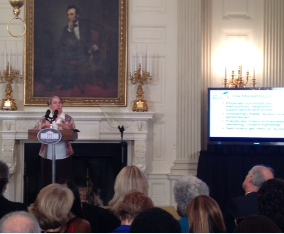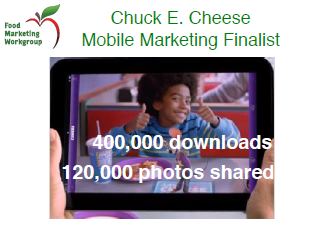Food marketing to children is not improving rapidly enough, Lori Dorfman tells White House audience
by: Carolyn Newbergh
posted on Friday, September 27, 2013

Far more needs to be done, and quickly, particularly because aggressive food marketing to children via mobile phones and other digital media is growing explosively, said Dorfman, a national authority on food marketing to kids who has written and spoken extensively on the subject.
“I told them I want to turbo charge movement around marketing to children because we need to move much faster. Researchers say that at the rate we’re going, we won’t have the right balance of ads on TV until 2033. We can’t afford to lose a generation of kids who are forming their ideas about what to eat based on billions of dollars of marketing bombarding them every year,” Dorfman said of the event, attended by representatives of food and media companies, advocacy and parents groups, government agencies and research organizations.
Inroads being made in marketing healthier food to kids
Dorfman pointed to some small signs of progress: About 90 percent of the ads Nickelodeon aired in 2005 were for junk food; last year, its junk food ads declined to about 70 percent of ads, Dorfman said. Also, members of a voluntary regulatory body, the Children’s Food and Beverage Advertising Initiative (CFBAI), have made pledges of their own choice to improve nutrients in the products they market to children, but by late 2014 all member companies will adhere to a consistent set of nutrition standards. Although a positive sign, this plan still doesn’t cover all the junk food marketing children are exposed to, she said.
Perhaps the White House meeting itself is the biggest harbinger of movement, said Dorfman, who also co-chairs the Food Marketing Workgroup.
“The fact we were there in the White House is a key indicator that this is an issue everyone takes seriously now,” said Dorfman.
Digital marketing “gets more eyeballs”
While food companies’ spending to push their products on children decreased slightly from about $2 billion in 2006 to $1.8 billion in 2009, this slight decline partly fueled by the recession was offset by a 50 percent increase in digital marketing, which is much less expensive to produce than television ads and “gets more eyeballs for the buck,” Dorfman told the gathering.
“A 30-second commercial is here and gone,” she said. “If you’re pushing a Froot Loop around the screen, you can be doing this for 10 minutes, 15 minutes and 30 minutes at a time and then sending it to a friend.”

For example, Chuck E. Cheese’s has used African American children to encourage kids to download an app, visit the restaurant and have a photo taken showing the giant Chuck E. Cheese mouse with his arms around them. This kind of marketing appeals to kids and has a long “shelf” life in their homes.
Broad voluntary regulations needed
Dorfman called for the CFBAI to put regulations in place covering all forms of advertising, including product packaging, sponsorships, and marketing in schools as well as stronger nutrition standards for healthy foods.
“Yes, parents have responsibility for their children, but parents don’t have responsibility for putting characters on cereal boxes at kids’ eye level on supermarket shelves,” she said. “Parents are not responsible for fruits snacks that are not fruit. Parents don’t have the power to change that. But the companies do.”
Carolyn Newbergh is a writer and editor in the Public Health Institute‘s communications department.



